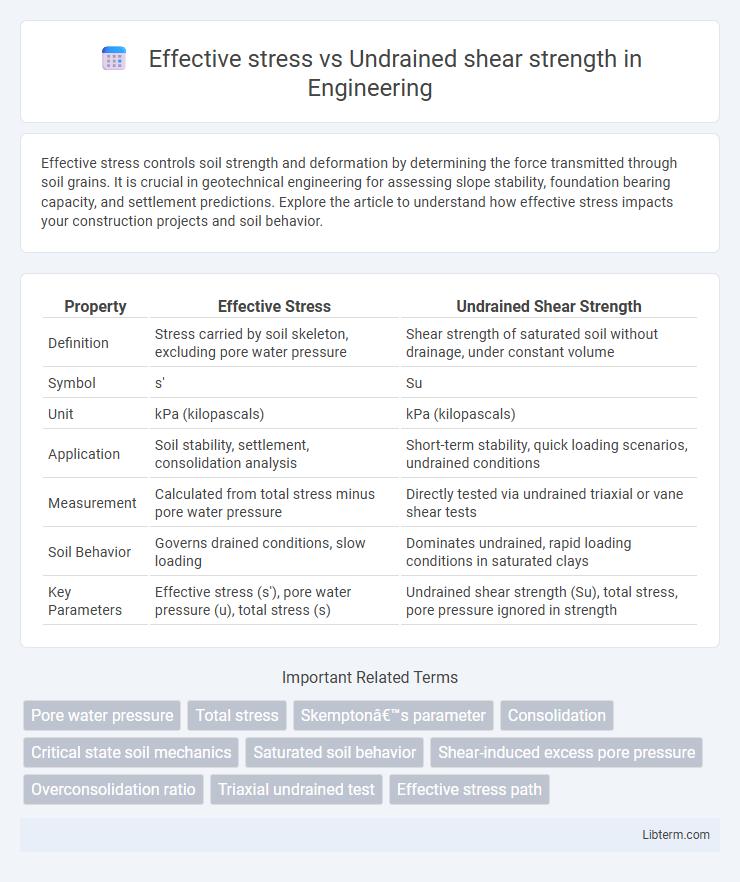Effective stress controls soil strength and deformation by determining the force transmitted through soil grains. It is crucial in geotechnical engineering for assessing slope stability, foundation bearing capacity, and settlement predictions. Explore the article to understand how effective stress impacts your construction projects and soil behavior.
Table of Comparison
| Property | Effective Stress | Undrained Shear Strength |
|---|---|---|
| Definition | Stress carried by soil skeleton, excluding pore water pressure | Shear strength of saturated soil without drainage, under constant volume |
| Symbol | s' | Su |
| Unit | kPa (kilopascals) | kPa (kilopascals) |
| Application | Soil stability, settlement, consolidation analysis | Short-term stability, quick loading scenarios, undrained conditions |
| Measurement | Calculated from total stress minus pore water pressure | Directly tested via undrained triaxial or vane shear tests |
| Soil Behavior | Governs drained conditions, slow loading | Dominates undrained, rapid loading conditions in saturated clays |
| Key Parameters | Effective stress (s'), pore water pressure (u), total stress (s) | Undrained shear strength (Su), total stress, pore pressure ignored in strength |
Introduction to Effective Stress and Undrained Shear Strength
Effective stress is the stress transmitted through the soil skeleton, crucial for understanding soil behavior under load, while undrained shear strength measures soil resistance to shear without drainage. Effective stress controls soil deformation and strength by accounting for pore water pressure, differentiating it from total stress. Undrained shear strength reflects soil stability in rapid loading conditions, particularly in clay soils where pore water pressure cannot dissipate quickly.
Definition of Effective Stress in Soil Mechanics
Effective stress in soil mechanics refers to the stress carried by the soil skeleton or particles, excluding pore water pressure, and is crucial for assessing soil strength and deformation. Undrained shear strength represents the maximum shear stress a saturated soil can withstand without drainage, primarily influenced by effective stress and soil structure. Understanding the relationship between effective stress and undrained shear strength helps predict soil behavior under various loading conditions during geotechnical analysis.
Understanding Undrained Shear Strength
Undrained shear strength reflects a soil's ability to resist shear deformation without drainage, primarily influenced by the pore water pressure under short-term loading conditions. It is a critical parameter in saturated clays where the total stress changes occur faster than pore water can dissipate, making effective stress less useful for immediate stability assessments. Understanding undrained shear strength is essential for analyzing soil behavior during rapid loading events such as earthquakes or construction activities.
Relationship Between Effective Stress and Shear Strength
Effective stress directly influences the undrained shear strength of saturated soils by governing the soil particle interactions and pore water pressure during loading. As effective stress increases, soil structure consolidates, enhancing resistance to shear deformation, which raises undrained shear strength. The correlation between effective stress and shear strength is critical for predicting soil stability in geotechnical engineering and guiding safe foundation design.
Mechanisms of Stress Transfer in Saturated Soils
Effective stress controls the shear strength in saturated soils by transferring load through solid soil particles, while undrained shear strength reflects the immediate resistance without drainage, influenced predominantly by pore water pressure. In saturated conditions, the mechanical interaction between soil skeleton particles bears the applied stress, whereas excess pore water pressure temporarily supports part of the load, reducing effective stress and affecting stability. The mechanism of stress transfer demonstrates how changes in pore pressure during loading can alter soil strength characteristics, critical for assessing slope stability and foundation performance in cohesive soils.
Factors Influencing Effective Stress and Undrained Strength
Effective stress is influenced by pore water pressure, soil type, and drainage conditions, which directly affect soil behavior under load. Undrained shear strength depends on soil consistency, rate of loading, and the degree of saturation, reflecting the soil's resistance without volume change. Soil structure and history also play critical roles in modifying both effective stress and undrained strength parameters.
Role of Pore Water Pressure in Soil Behavior
Pore water pressure critically influences the relationship between effective stress and undrained shear strength in saturated soils by reducing the effective stress that governs soil particle interaction. During undrained loading, an increase in pore water pressure decreases the soil's effective stress, directly diminishing its shear strength and leading to potential failure. Understanding pore water pressure dynamics is essential for accurate prediction of soil behavior under undrained conditions in geotechnical engineering.
Laboratory Testing: Effective vs Undrained Shear Tests
Laboratory testing differentiates effective stress tests, which measure soil strength under drained conditions allowing pore water pressures to dissipate, from undrained shear tests that assess soil behavior under constant volume conditions with no pore pressure adjustment. Effective stress tests, such as consolidated drained triaxial tests, provide critical data on shear strength parameters considering pore pressure effects and long-term stability. Undrained shear strength tests, like unconsolidated undrained triaxial or vane shear tests, are vital for assessing short-term soil strength immediately after loading, especially in saturated clays prone to rapid pore pressure buildup.
Practical Applications in Geotechnical Engineering
Effective stress controls soil behavior by determining strength and deformation characteristics critical for foundation and slope stability analysis. Undrained shear strength, measured during rapid loading conditions, is essential for evaluating short-term stability in saturated clays and designing earthworks where drainage is limited. Integrating both parameters improves the reliability of geotechnical models for construction safety and performance assessment.
Conclusions and Engineering Implications
Effective stress directly influences soil strength by controlling particle interlocking and friction, while undrained shear strength reflects soil behavior under rapid loading without pore water pressure dissipation. Understanding their relationship is crucial for accurate slope stability and foundation design in saturated soils. Engineering implications emphasize the need to incorporate effective stress conditions in predictive models and to consider undrained shear strength for short-term stability assessments in cohesive soils.
Effective stress Infographic

 libterm.com
libterm.com